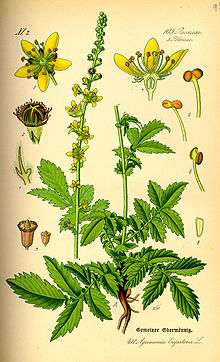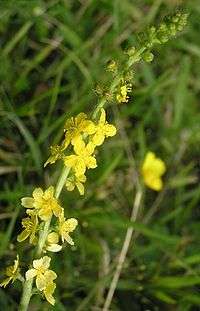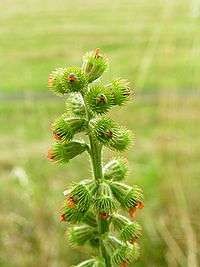Agrimonia eupatoria
Agrimonia eupatoria is a species of agrimony that is often referred to as common agrimony, church steeples or sticklewort.
| Common agrimony | |
|---|---|
 | |
| Agrimonia eupatoria | |
| Scientific classification | |
| Kingdom: | Plantae |
| Clade: | Tracheophytes |
| Clade: | Angiosperms |
| Clade: | Eudicots |
| Clade: | Rosids |
| Order: | Rosales |
| Family: | Rosaceae |
| Genus: | Agrimonia |
| Species: | A. eupatoria |
| Binomial name | |
| Agrimonia eupatoria | |
The whole plant is dark green with numerous soft hairs. The soft hairs aid in the plant's seed pods sticking to any animal or person coming in contact with the plant. The flower spikes have a spicy odor like apricots. In the language of flowers, agrimony means thankfulness or gratitude.[1]
A. eupatoria is a foodplant for the caterpillars of the snout moth Endotricha flammealis.
Description


Vegetative characteristics
The common agrimony grows as a deciduous, perennial herbaceous plant and reached heights of up to 100 cm (39 in). Its roots are deep rhizomes, from which spring the stems. It is characterized by its typical serrated edged pinnate leaves.[2]
Generative characteristics
The short-stemmed flowers appear from June to September, in long, spike-like, racemose inflorescences. The single flower has an urn-shaped curved flower cup, the upper edge has several rows of soft, curved hook-shaped bristles, 1–4 mm (0.039–0.157 in) long. The hermaphrodite flower has fivefold radial symmetry. There are five sepals present . There are five yellow, rounded petals.[2] The petals and the five to 20 stamens rise above the tip of the flower cup . The two medium-sized carpels in the flower cups are sunk into, but not fused with it.
In folklore
Agrimony has been stated to have medical and magical properties since the time of Pliny the Elder. It is ruled astrologically by Cancer, according to Nicholas Culpeper. Common folklore held that it could cure musket wounds and ward off witchcraft.
Traditional British folklore states that if a sprig of the plant was placed under a person's head, they would sleep until it was removed.[3]
Ecology
The flowers with their abundant pollen supply attract hoverflies, flies and honey bees. They also are an important food source for butterflies like the grizzled skipper.[4] The pollinated flowers develop fruits with burs. These attach to passing grazing animals such as cattle, sheep and deer and are spread over a large area.[2] Agrimony is found usually in young grasslands, less than 50 years old.[5]
Chemistry
Contains volatile oils, flavonoids, apigenin, luteolin, quercetin, kaempferol, tiliroside, triterpene glycosides including euscapic acid and tormentic acid, phenolic acids, and 3%–21% tannins.[6]
Notes
- "Agrimony Wildflowers". Archived from the original on 2013-12-26.
- Grieve, Mrs M. "Agrimony". A Modern Herbal. Botanical.com. Retrieved 2011-06-23.
- Encyclopedia of Folk Medicine: Old World and New World Traditions By Gabrielle Hatfield, p.310
- Streitberger, Merle; Fartmann, Thomas (2013-01-01). "Molehills as important larval habitats for the grizzled skipper, Pyrgus malvae (Lepidoptera: Hesperiidae), in calcareous grasslands" (PDF). European Journal of Entomology. 110 (4): 643–648. doi:10.14411/eje.2013.087. ISSN 1210-5759.
- M. Ingrouille, Historical Ecology of the British Flora, p219
- Frances Watkins; Barbara Pendry; Alberto Sanchez-Medina; Olivia Corcoran (2012). "Antimicrobial assays of three native British plants used in Anglo-Saxon medicine for wound healing formulations in 10th century England Original Research Article Pages 408-415" (PDF). Journal of Ethnopharmacology. 144 (2): 225–456. doi:10.1016/j.jep.2012.09.031. PMID 23026307.
References
- Howard, Michael. Traditional Folk remedies (Century, 1987, pp 96–97)
External links
![]()
